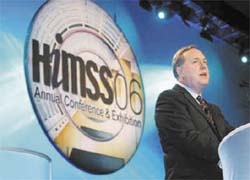Decade of IT under-funding in the USA
EH correspondent Cynthia E Keen reports on the HIMSS meeting in San Diego
The destruction caused by Hurricane Katrina was felt so strongly at HIMSS '06, the annual meeting of North America's Healthcare Information and Management Systems Society, which drew over 24,500 healthcare IT professionals and hospital executives to San Diego in February, that the Society decided to hold its 2007 meeting in New Orleans to bring dollars to the city's damaged economy.

The HIMSS 06 theme - Transforming healthcare through IT — had greater urgency in the context of destruction of hundreds of thousands of medical records and the need to provide medical care for tens of thousands of evacuees, many with no knowledge of their own medications. The resiliency of electronic medical records, and the need for medical professionals to access them regardless of location, reinforced the relevance of the keynote speeches and over 300 educational presentations (CD available at: www.himss.org).
A 2005 report from the PricewaterhouseCoopers Health Research Institute and Global Technology Centre estimated that a typical US hospital spent 2.5% of its annual operating budget on healthcare IT, approximately US$14 billion in 2005, and should spend a minimum of 3-5% in 2006. The message at HIMSS’06 was that investments made in the past decade are insufficient.
Modern Healthcare magazine’s 2006 annual survey of hospital administrators regarding the top ten IT priorities for 2006/2007 mirrored the major topics discussed: creating cost-effective, productivity-oriented, open standards-designed electronic patient records (EPR); strategic planning and management of clinical IT innovations; improvement of patient care and clinical decision-making to maximise budgets and reduce healthcare costs; security, and the development of viable information sharing networks through Regional Healthcare Information Organisations (RHIOs).
However, in 1993, at the first HIMSS meeting the topics were much the same, with additional emphasis then on the need for mature open standards. Fewer than 5,000 people attended, and many seemed to disbelieve the radical changes predicted. In the early 90s, the concept of RHIOs were called Community Healthcare Information Networks (CHINs), with emphasis on their formidable challenges of implementation and financing. Only a handful of CHINs ever materialised, but they created the models for Integrated Delivery Networks (IDNs) among healthcare institutions with multiple hospitals and clinics.
Now, in 2006, the IT revolution is well underway, with impressive pioneering initiatives by Canadian provincial and federal health departments and the US Armed Forces and military veterans hospitals, highlighted at the two countries’ pavilions. HIMSS’ joint initiative with the RSNA — Integrating the Healthcare Enterprise (IHE) - has achieved global support among vendors and healthcare institutions in industrialised nations. An Interoperability Showcase, modelled as a RHIO, demonstrated the exchange of physician reports, medical tests and lab results, and diagnostic images by 47 vendors. Some 3,000 attendees participated.
Keynote speakers included Dr David Brailer, new US National Coordinator for Health Information Technology, who is overseeing new $61,700,000 federal government funding initiatives for health IT deployment; Richard Alverez, president and CEO of Canada Health Infoway, an organisation representing Canada’s provincial and territorial health departments that to date has funded over $400 million to create an interoperable pan-Canadian Electronic Health Record (HER); and Richard Granger, chief executive of Connecting for Health, the United Kingdom’s multi-billion dollar initiative to create an IT-focused healthcare system.
Among the 875 exhibitors were global corporations such as Agfa Healthcare, Cerner Corp., Eastman Kodak, Eclipsys Corporation, GE Healthcare, McKesson Corporation, Philips Medical Systems and Siemens Medical Solutions, all demonstrating comprehensive, integrated systems for ‘one stop’ shopping that encompassed hospital EMRs, specialty department-specific information systems, PACS for radiology and cardiology, and speech recognition systems. Dell, EMC Corporation, IBM, Network Appliance and StorageTek showed the latest in CAS and SAN storage and archiving. State-of-technology in mobile computing, bar coding, security and virus protection, and wireless telecommunications also were highlighted. Exhibitors also included numerous IT infrastructure designers, service providers and consultants. This mix attracted several thousand IT professionals from Europe and Asia, for whom the appeal was to evaluate commercially available and emerging healthcare IT technology that was debuting at the show.
01.05.2006





